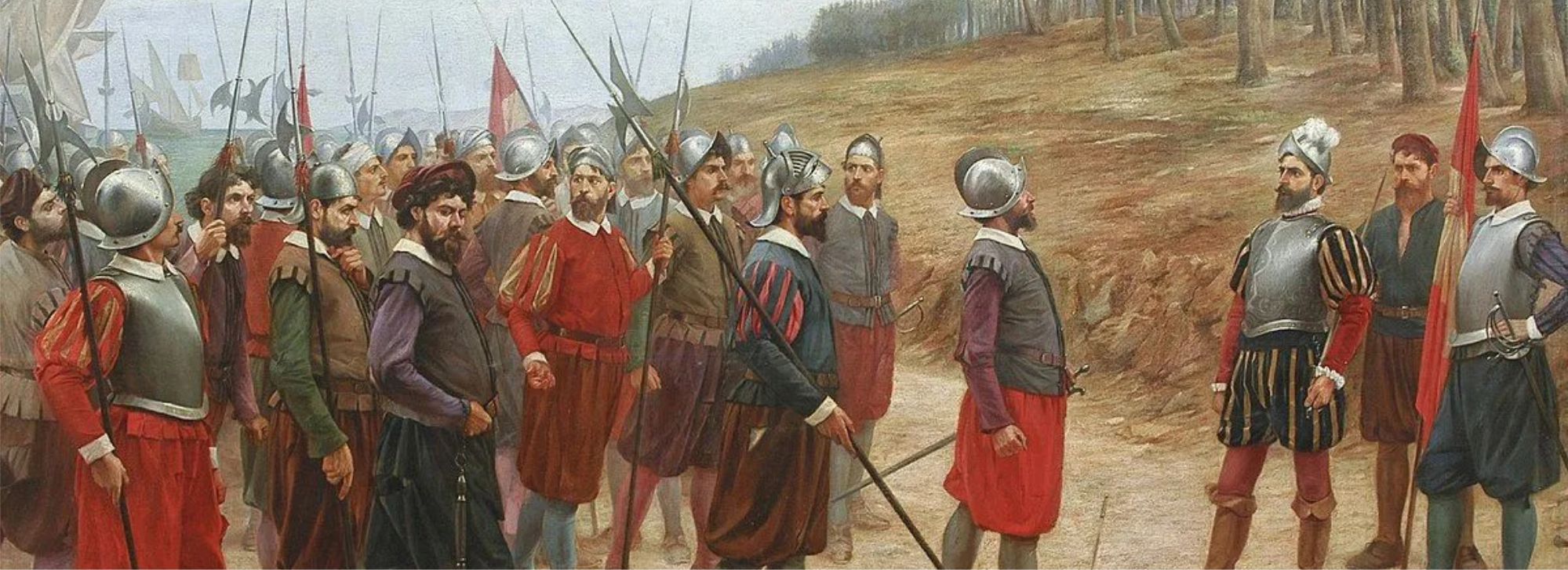Fragments for a history of Galapagos
The conquistador who came fleeing
After the discovery of the islands by the Spanish bishop Tomás de Berlanga in 1535, the Galapagos vanished from the historical record. But only for a few years. They reappeared in 1546, with the adventure of Diego de Rivadeneira.
At that time, the so-called Civil War between the Conquistadors of Peru (1537-1554) was raging. Gonzalo, the last of the Pizarro brothers alive in American lands, and by then a rich encomendero of the Royal Audiencia of Charcas (present-day Bolivia), had risen up in 1544 against the Leyes Nuevas ("New Laws") decreed by Charles I in November 1542, within the framework of the so-called "Rebellion of the Encomenderos": conquerors who had been deprived, thanks to this new legislation, of the right to hereditary encomiendas ― i.e. to the slave exploitation of Andean indigenous peoples. "Pizarristas" (Pizarro's followers) raised an army and confronted the first viceroy of Peru, Blasco Núñez de Vela, who ended up being defeated in Iñaquito (January 1546) and decapitated on the battlefield.
Knowing of such events and loyal to the Hispanic Crown, Captain Diego Centeno took up arms against Pizarro and his people in the city of La Plata (today Sucre, Bolivia) and tried to reinstate the royal power. Hence, Pizarro sent his lieutenant Francisco de Carvajal, a veteran conquistador infamous for his "bad and cruel condition" and who ended up being nicknamed "the Demon of the Andes".
Carvajal began a long pursuit of Centeno's troops. From Cusco he reached Oruro, in the Bolivian highlands, where he confronted his rival. Centeno, who had substantially inferior forces, barely avoided a massacre and, in disband, managed to reach Arequipa with his troops.
From there, the royalist leader sent one of his subordinates, Captain Diego de Rivadeneira, accompanied by a dozen of his men, to the nearby port of Quilca to look for a ship on which to embark and head for Lima. Rivadeneira reached the coast, but the locals informed him that the nearest ships were about one hundred and fifty kilometers to the south, in the port of Arica, in present-day Chile.
They made their way to Arica, where they seized a ship by trickery and set sail for Quilca, to pick up the rest of their companions. However, when they finally arrived, they did not find Centeno. He had been there days before and, not finding Rivanedeira, and fearing reprisals from Carvajal, who was on his heels, he had disbanded his troops (about forty men) and had hidden among the indigenous communities in the nearby mountains. The one who was actually waiting for them was Carvajal himself, who had somehow learned of his adversaries' plans. With deceit and false promises, he wanted to make Rivadeneira disembark, but the latter decided to continue his journey, heading to Nicaragua.
Unfortunately, the ship had no compass or nautical charts, and did not even have enough provisions. Fearing apprehension by the opposing faction, the escapees stayed away from the coast, and the Humboldt Current ended up dragging them to the Galapagos, twenty-five days after setting sail from Quilca.
One of the most tragic anecdotes of that voyage was the attempt to catch a sea turtle for food. One of the youngest members of the expedition straddled the animal's back while the others tried to tie it up. But, due to a change of wind or currents, turtle and boat got apart, and the boy, who could not swim, was left clinging to the reptile's back, alone in the middle of the ocean.
Finally, after leaving the archipelago behind, the small crew managed to reach the coasts of Central America, disembarking in the town of San José Ixtapa, in present-day Mexico.
Apparently, there is an account of the voyage with a succinct description of the islands included by the royal treasurer Pedro Castellanos in a missive to king Philip II. There are also news of that navigation noted by Pedro de la Gasca, president of the Royal Audience of Lima, and by the chronicler Pedro Cieza de León in the third book of his Guerras civiles del Perú ("Civil Wars of Peru"). The latter, written around the middle of the 16th century and published for the first time by Marcos Jiménez de la Espada in 1877 (based on an incomplete manuscript in the Library of the Royal Palace of Madrid), is probably the best known source for these facts: specifically chapter CCVII, entitled "How Captain Diego de Rivadeneira reached the port of Quilca, and how he was brought to New Spain and on the way saw a very large island".
None of the authors of this adventure seem to be aware of the existence of the letter from Tomás de Berlanga to Charles I, reporting the discovery of the Galapagos.
As an epilogue, it is worth mentioning that Carvajal ended up defeating Centeno in the battle of Huarina, in October of 1547, although at that moment the "pizarrista" faction had already disbanded. Carvajal was executed together with Gonzalo Pizarro in 1548, after his final defeat in the battle of Jaquijahuana; his house was demolished and the land, sown with salt. A year later, Centeno died of fevers. Diego de Rivadeneira made a formal request to Pedro Castellanos to be granted the right of exploration, colonization, and government of the Galapagos ― a request that fell on deaf ears. After that, the name of the Spanish captain disappeared forever from the historical records.
[The image that illustrates this text corresponds to a painting representing "The 13 of Rooster Island"].
References
Cieza de León, Pedro (1877). Tercero libro de las Guerras civiles del Perú el cual se llama La Guerra de Quito. [Published by Marcos Jiménez de la Espada]. Madrid: Imprenta de M. G. Hernández.
Text & picture: Edgardo Civallero (edgardo.civallero@fcdarwin.org.ec).
Publication date: 1 October 2023
Last update: 1 October 2023
